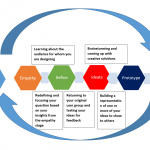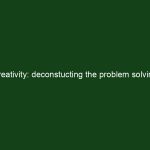Productivity burnout is one of my favorite subjects, maybe because I had several close encounters with the phenomenon. I suffered work-related burnout periods more than once, and so did most of my students and friends. Each time I address the subject, I choose a slightly different perspective. Hope there will be some new ideas in …
Why Authenticity is an Essential Element for the Writer’s Personal Brand
Honesty and personal style are very importand for any creative work, including effective memorization practice. They can also be very important for effective communication and your career. A professional writer and marketer Jade Parker argues that anyone can develop true authenticity following very simple guidelines, at least when writing. Try to see if you can apply …
Continue reading “Why Authenticity is an Essential Element for the Writer’s Personal Brand”
How to Implement Design Thinking in the Classroom
You have probably noticed, that around 50% of our new content is dedicated to guest articles. Brenda Savoie is a private English tutor and desperate dreamer. Writing her first romantic novel. Check her blog Best Writing Clues. Find her on Twitter and Facebook. This particular subject was chosen for several reasons. First, it is very …
Continue reading “How to Implement Design Thinking in the Classroom”
Creativity: deconstucting the problem solving skills
There is a lot of interest in metalearning and metacognition. Metalearning deals with deconstructing the way we learn. Metacognition deals with deconstructing the way we solve problems. Today I prepared an especially good selection of reading material. Please do spend your time to read here, here, here, here, and here. Four stages of problem solving …
Continue reading “Creativity: deconstucting the problem solving skills”
5 Mistakes You Should Avoid When Mentoring
This guest post was written by a very young journalist, Mia Stokes. This is how she defines herself: “I am a journalist. I use my writing skills in a professional manner to help people to find something useful, informative and relevant to their interests. I’m happy to share my knowledge, tips, and advice in my articles. …
Continue reading “5 Mistakes You Should Avoid When Mentoring”
Reading, rereading and ghosting effects
Quite often true memories are mixed up with false memories. Quite often this happens when we read too slow. For today’s article, you may want to read here, here, here, here, and here. This article is inteded to be an overview: each of the subjects was already discussed in some other form on this blog. …
Mental wardrobe
This is a short post to offer a very specific solution for mental palaces. here is another explanation of the same subject. Suppose you have a mental palace, with nice memorable walls and corners. I assume you are already comfortable placing markers along the walls. Maybe small objects, maybe mindmaps and maybe PAO markers. You …
Getting out of comfort zone
Getting out of the comfort zone is important for personal growth and crucial for any attempt of achieving greatness. After my marriage with Anna she was convinced I am not living to my potential. So she made it a personal goal to take me out of my comfort zone. This is not an easy task, …
Apps and creativity
Some apps help us become smarter and more creative in strange and wonderful ways. Apps and games improve problem solving skills, brain processing speed, visual skills and memory. This post is inspired by reading this article and here. Less interesting reading here,here, here. Problem solving skills It is understandable that playing strategy games we develop …
The power of small changes
It is very difficult to make changes in our life. Once we do master the required energy and motivation, we prefer to do dramatic actions. We may get a huge success, but then find it very hard to maintain this success for a long time. Small changes reduce the risk and increase the success rate. …











